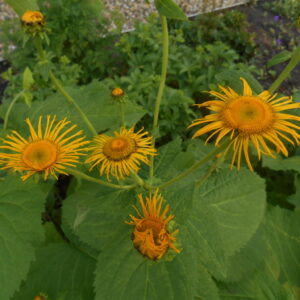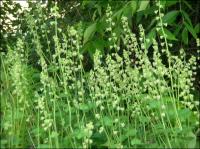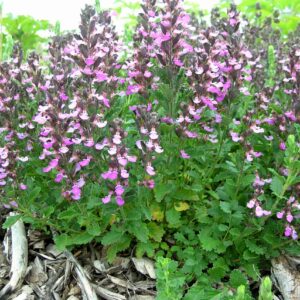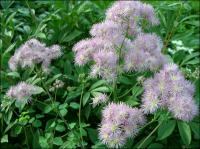Shop
Showing 721–728 of 788 results
-
Telekia speciosa syn. Buphthalum speciosum Z 3-7
Big, sunflower-like blooms but with the thinnest of petals, deep yellow, with orange-yellow centers. Flowers June-July. Curtis’s Botanical Magazine 1836, “copious blooms.”
Big, sunflower-like blooms but with the thinnest of petals, deep yellow, with orange-yellow centers. Flowers June-July. Curtis’s Botanical Magazine 1836, “copious blooms.”
Size: 4-5’ x 2-3’
Care: sun to part shade in moist to moist well-drained soil
Native: mountains of southern EuropeGrown by Philip Miller in 1739, head gardener at London’s Chelsea Physic Garden, per 1836 Curtis’s Botanical Magazine.
-
Tellima grandiflora Fringecups Z 4-8
Pixie whitish fringed cups
OUT OF STOCK
Pixie whitish fringed cups bloom on 2′ tall panicle from May to July.
Size: 12"x 8"
Care: Part shade in moist well-drained to well-drained soil
Native: Pacific Northwest to AlaskaNitinaht Indians of Vancouver Island and Canadian Indians chewed this as a panacea and also to prevent a person from dreaming about necrophilia. The western Washington Skagit Indians took a mixture including pounded Fringecup to enhance appetite and to heal all ailments. 1st collected by Scotsman Archibald Menzies around 1790 on the Vancouver expedition. Introduced to gardens in 1826.
-
Teucrium chamaedrys Wall Germander Subshrub Z 5-9
Fragrant red-purple or bright rose flowers on this evergreen subshrub, July-September
Fragrant red-purple or bright rose flowers on this evergreen subshrub, July-September
Size: 1-2' x 12"
Care: sun in well-drained soil
Native: Caucasus MountainsTeucrium is named after Teucer, the 1st king of Troy. Chamaedrys means “ground oak” referring to foliage like miniature oak leaves. Grown in the Eichstätt Garden, the garden of Johann Konrad von Gemmingen, prince bishop of Eichstätt in Bavaria, c. 1600. Historically used to cure gout, fevers, and headaches, Grown in herb gardens and knot gardens. William Robinson: “useful edging plant, also good as a dwarf hedge.” Used as a hedge at Mount Vernon.
-
Teucrium hircanicum syn. T hyrcanicum Iranian germander, Purple Tails, Wood Sage Z 5-8
Loads of deep purple erect spikes from mid-summer through fall making this subshrub one of the best
Loads of deep purple erect spikes from mid-summer through fall making this subshrub one of the best
Size: 18-24” x 24”
Care: sun in moist well-drained to well-drained soil
Native: Caucausus and Iran
Wildlife Value: attract butterflies, deer resistantDescribed and named by 1753
-
Teucrium montanum Mountain germander, Creeping germander Z 5-8
Evergreen, narrow leaves covered with bouquets of flowers topped with a pair of upright, clasping petals streaked with burgundy, leading to a pair of open, white arms and a single, drooping white petal all resembling a snowman with a pointed red-streaked head blooming all summer on this spreading, cover-the-ground, drought-tolerant plant.
Evergreen, narrow leaves covered with bouquets of flowers topped with a pair of upright, clasping petals streaked with burgundy, leading to a pair of open, white arms and a single, drooping white petal all resembling a snowman with a pointed red-streaked head blooming all summer on this spreading, cover-the-ground, drought-tolerant plant.
Size: 10” x spreading
Care: sun in well-drained soil
Native: Spain across the Alps and east as far as TurkeyThe word teucrium believed to be named for Teucer, king in ancient Troy . He reputedly made medicine from teucrium. Known more than two centuries ago in ancient Greece and Rome
-
Thalictrum alpinum Alpine meadowrue Z 2-9
Flowering June, purple skirt surrounding dangling yellow anthers on this petite Meadowrue
OUT OF STOCK
Flowering June, purple skirt surrounding dangling yellow anthers on this petite Meadowrue
Size: 8” x 4”
Care: sun to part shade in moist to moist well-drained soil
Native: Mountains Western US, north to Alaska, Eastern Canada, Siberia, Europe & ChinaThalictrum is from Greek meaning “to flourish” or “look green.” In China called “gao shan tang cao.” Collected before 1679.
-
Thalictrum aquilegifolium Meadowrue, Feathered columbine Z 5-9
Delicate lavender to pink panicles of showy stamens in early summer
Delicate lavender to pink panicles of showy stamens in early summer
Size: 36" x 18"
Care: Sun to part shade in moist humusy soil
Native: Europe and North Asia
Wildlife Value: attracts Black swallowtail butterflyThalictrum is from Greek meaning “to flourish” or “look green.” In 1629 Parkinson, apothecary to James I and later, botanist to Charles I, called this “Tufted columbine” a descriptive name, the flowers are tufted, and the leaves resemble those of a columbine. Ancient Romans used it to cure ulcers, the plague and “the Faundife.” Romans stuffed children’s’ pillows with the flowers to bring them wealth. Liberty Hyde Bailey described Thalictrum aquilegifolium as: “A good garden plant and frequently planted,”(1933). Cultivated in U.S. since 1700’s.
-
Thalictrum coriaceum Maid of the Mist Z 5-7
Broad panicle of white flowers with maroon-colored filaments and tips of stigma flowering May to June
Broad panicle of white flowers with maroon-colored filaments and tips of stigma flowering May to June
Size: 3-5’ x 2’
Care: sun to shade in moist to moist well-drained soil
Native: Uncommon, central and southern Appalachian endemic, Pennsylvania to northern Georgia west to West Virginia and Tennessee, primarily in the mountainsFirst described in 1891 in “Torrey Bot. Club” 18:363, 1891. Collected on Rock Table and Stone Mountains in North Carolina in 1891 by J.K. Small (1869-1938) and A.A. Heller and by “Professor Porter in the same region many years before.”






